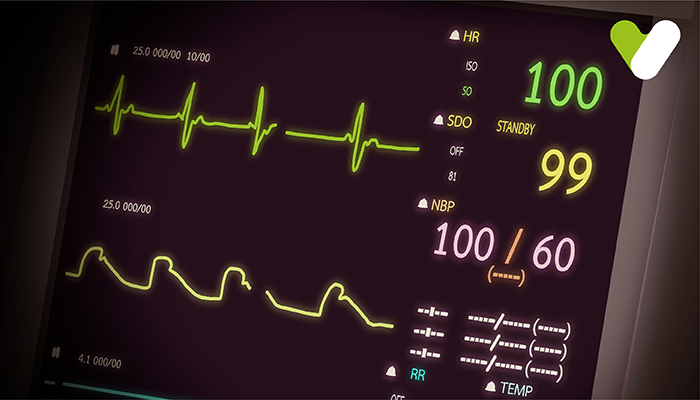Prathik has recently come across a video online that depicts a heartbeat line. He was quite interested in that heartbeat line and wants to learn more about it. Do you want to learn more about this topic too? If yes, then today is your lucky day as we are going to take up this topic now.
What is a Pulse Wave or Heartbeat Line?
Pulse or a heart rate can be defined as the wave of blood in the artery that is created due to the contraction of the left ventricle during a cardiac cycle. The strength, which is also known as the amplitude, of the pulse reflects the amount of blood that is ejected with myocardial contraction. This is also known as stroke volume.It should be noted that the normal pulse rate range for an adult is usually between 60 - 100 beats per minute. In comparison to this, the normal resting heart rate of a well-trained athlete is between 40 to 60 beats per minute. The heart rate of an individual is directly related to the heartbeat line.
Different Types of Pulse Rate
There are two types of pulse rates that can be measured and observed through heartbeat lines. These two types of pulse rates are:- Peripheral Pulses: These pulse rates can be felt at the periphery of the body. This is done by palpating an artery over a bony prominence. Some examples include popliteal, radial, and carotid pulses
- Apical Pulses: This is a type of central pulse that is located on the apex of the heart. This can be monitored by using a stethoscope
Factors Affecting Heartbeat Line
There are several factors that can influence the heartbeat line. Some of these factors are:- Sex
- Age
- Emotions
- Stress
- Exercise
- Medication
How to Check for Pulse?
As a general rule, it is quite easy to take the pulse at the wrist. Some individuals prefer to take their pulse by using their lower neck. And if you also prefer that, then make it a point to note press too hard. Further, you should never press on the pulses on both sides of your lower neck at the same time. This is done to prevent the blocking of blood flow to the brain.The exact steps that you can follow to measure your own pulse are:
- Use the first and second fingertips to press firmly but gently on the arteries until you feel your pulse
- Begin counting the pulse when the second hand of the clock strikes 12
- Do not watch the clock continuously when counting. Instead, concentrate on the beats of the pulse
- If you are unsure about your results, then you can also take the help of some other individual in calculating your pulse
Parameters of Pulses
There are different parameters and factors involved in calculating and observing heartbeat lines. Let’s look at some of those parameters now.- Rate: The rate can be defined as the number of pulsations. This could be Bradycardia, which refers to less than 60 pulsations in a minute, or Tachycardia, which refers to more than 100 pulsations in a minute
- Rhythm: Rhythm can be defined as the time interval between pulse beats.
Complications and Treatments
While learning about heartbeat lines, one should also remember that there can be several abnormalities that one might observe in their heartbeat. These abnormalities might also give rise to symptoms like:- Fatigue
- Shortness of breath
- Near-fainting
- Fainting
- Dizziness
- Lightheadedness
- Chest pains
- Easily becoming tired during physical activity
- Memory problems
- Confusion
- Age
- High blood pressure
- Smoking
- Heavy alcohol use
- Recreational drug use
- Psychological stress
- Anxiety
- Hypothyroidism
- Inflammatory diseases like rheumatic fever
- Frequent failure spells
- Heart failure
- Sudden cardiac arrest
- Sudden death
The Prevention
Prathik is not happy after learning about all these problems and complications. After going through these lists, he has realized that he is also guilty of indulging in some of these harmful habits. But the good part is that he doesn’t want to continue this way anymore. He wants to make some changes. And to make those changes, he needs to follow the tips that we have mentioned below.- Exercise regularly
- Maintain a healthy weight
- Do not smoke
- Avoid the consumption of alcohol
- Keep your blood pressure and cholesterol under control
- Manage your stress and anxiety levels
- Schedule regular medical checkups to make sure everything is good
Measuring Heartbeat Line through Electrocardiography (ECG)
Individuals and medical experts can determine the heartbeat line and rate through an electrocardiography (ECG) device. In this device, if the cardiac rhythm is regular, then the interval between two successive QRS complexes can be used to determine the heart rate.A standard paper can be taken with the most common tracing settings. The heart rate can be calculated by dividing the number of large boxes between the two successive QRS complexes into 300.
For example, if the interval between two QRS complexes is two large boxes, then the heart rate is 150 beats per minute, which is also known as bpm. To arrive at this value, one needs to carry out the following calculation:
300 ÷ 2 = 150 bpm
Today Prathik has learned a lot about the heartbeat line. He has even spent time learning about the tips that he can practice to have a healthy heart. Has your day been just as productive and beneficial as Prathik’s day?


